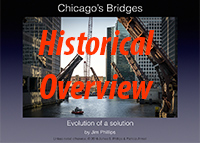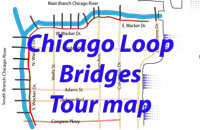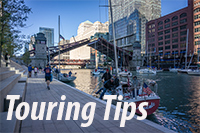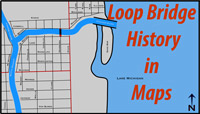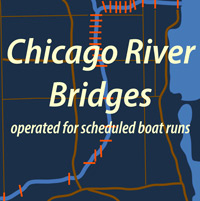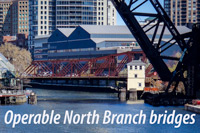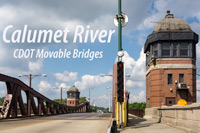When were the "outboard" sidewalks on the lower deck of the Du Sable Bridge at Michigan Ave added?
Is the Carroll Ave railroad bridge (the bridge in the raised position) near Kinzie St abandoned?
What bridge has the lowest clearance on the Chicago River?
Does thermal expansion affect these bridges?
Which bridge was used as a home?
Which of these bridges is the: Widest? Longest? Heaviest leaf? Oldest? Youngest? Most vehicles? Most pedestrians? Most photographed?
Why did Chicago's bridges have to be movable?
How old are the current bridges?
Why are the bridges still operated?
What equipment is used to raise a bridge?
How quickly can the machinery raise the bridge leaves?
Are all bridge tender houses needed to operate a bridge?
How many people are needed to operate the bridges?
What is the average travel time for a boat to travel through these 18 bridges?
Why are there different number of lifts for these bridges?
Do the number of lifts change significantly from year-to-year?
Why do some bridges only open one leaf?
How much does it cost Chicago to operate a bridge?
How much paint does it take to paint a bridge?
Why are there barges under some of the bridges?
What is the maintenance program for these bridges?
How deep are the pits that hold the counter weights for the bridges?
What is the purpose of lights in the center of the bridges?
Your question missing? Ask it here.
****
When were the "outboard" sidewalks on the lower deck of the Du Sable Bridge at Michigan Ave added?
1972 - sidewalks on the lower deck were originally on the inside of the supporting trusses. In the early 1970's (coincident with the Illinois Central Air Rights project) a project to repair the viaduct supporting upper Michigan Ave from Randolph St to the Chicago River was undertaken. As a part of this project, this stretch of Michigan Ave including the bridge was widened. Traffic lanes on both decks of the bridge were widened and lower deck sidewalks moved to the outside of the trusses. A Chicago Tribune photograph in the February 6th, 1972 edition captures the new sidewalk in use.
Is the Carroll Ave railroad bridge (the bridge in the raised position) near Kinzie St abandoned?
The Carroll Ave railroad bridge is not abandoned. It is owned by Union Pacific. There is no regular traffic across the bridge but is operated and crossed with a high rail vehicle (pick-up outfitted to travel on rails) once per year by the railroad to maintain the right of way. (Thanks to Adrian Guerrero at UP for this information)
What bridge has the lowest clearance on the Chicago River?
The bridge with the lowest clearance on the Chicago River is the Du Sable Bridge at Michigan Avenue. Its clearance is 17 feet at Low Water Datum. Other bridges on the Chicago river and its branches range from 18' to 31'. (Thanks to Darryl Rouse for this information)
The Chicago fireboat the Christopher Wheatley was designed to navigate the Chicago River without requiring the bridges to be raised. What is its air draft?
The air draft of the Christopher Wheatley with the mast folded is 16'.
Does thermal expansion affect these bridges?
Yes. On hot days, bridges can expand enough that they cannot be closed until cooled. The photograph below shows a cooling operation at the State St. bridge during a lift on 5/26/2010 when the temperature was 85°+. (photo provided by a friend of the site)
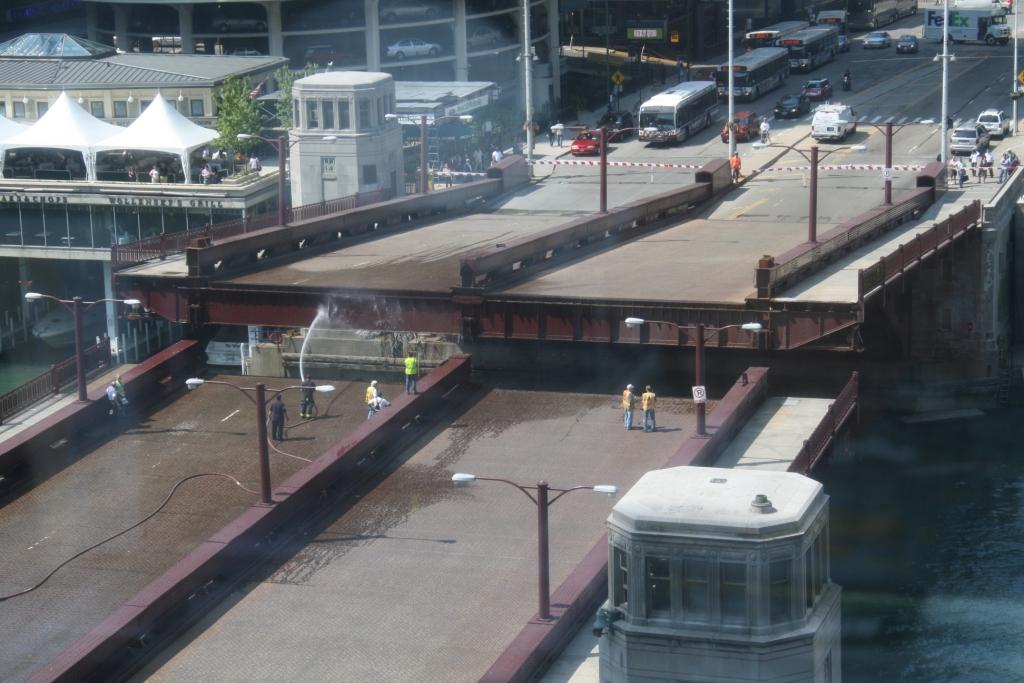
Why doesn't the rack and pinion have any grease?
The rack and pinion are lubricated with graphite because the mechanism is exposed and subjected to trash and debris. Grease would tend to trap the debris in the mechanism, whereas the graphite does not.
Which bridge was used as a home?
The N. Lake Shore Dr. bridge was used by Richard Dorsay as home. He had built a shelter between the beams and girders under the deck. He reportedly was able to tap into power for a space heater, TV, microwave, and video games. He was found and evicted in December 2004. Ira Glass of "This American Life" interviewed Mr. Dorsay recently in the Prologue to the episode entitled The Bridge.
Which of these bridges is the:
N. Columbus Dr. bridge is the widest at 111 feet.
N. Wabash Ave. and N. Columbus Dr. are tied at 232 feet.
N. Lake Shore Dr. has the heaviest leaf at 6,420 tons.
W. Washington Blvd. at 99 (built in 1913).
W. Randolph St. bridge is 28 years (built 1984). The oldest and youngest bridges are neighbors on the South Branch.
112,000 vehicles cross N. Lake Shore Dr. bridge every day.
Approximately 42,000 pedestrians cross the W. Madison St. bridge every day.
Most photographed? The Du Sable Bridge at N. Michigan Ave. bridge is the most photographed and most recognizable bridge.
Why did Chicago's bridges have to be moveable?
The Chicago area was a large swampy area that provided an easy portage from Lake Michigan to the Des Plaines River and beyond. This geography ensured that it would become the major transportation hub for waterborne traffic from the Great Lakes to the Mississippi River. As the city grew, land based traffic crossing the Chicago River competed with waterborne traffic on the river and made numerous bridges essential. Because of the low lying nature of Chicago, movable bridges were the most practical solution.
How old are the current bridges?
These bridges range in age from 28 (West Randolph Street) to 99 (West Washington Avenue) years. The median age of this group is 84 years.
Why are the bridges still operated?
The Chicago River is considered a navigable waterway. As such, the federal government requires that there be no barriers (including bridge leaves) to waterborne traffic.
What equipment is used to raise a bridge?
At the time these bridges were built, they were fitted with the current equipment of the era. At this stage in their lives, the equipment has been standardized. The bridges are fitted with two or more 125 horsepower motors (about the size of the engine in a sub-compact Honda Fit), depending upon the bridge.
How quickly can the machinery raise the bridge leaves?
Once engaged, the bridge leaves open in approximately one minute.
Are all bridge tender houses needed to operate a bridge?
No. As you walk along the river you will notice that there are as many as four to as few as one bridge tender house at a bridge. Depending upon the bridge, lifts are controlled from one or two of the bridge tender houses.
How many people are needed to operate the bridges?
In addition to the bridge tender, a number of people are required to ensure pedestrians and cars are clear of the bridge during a lift. According to the Bridge Operations office, bridges at North Lake Shore Drive, North Michigan Avenue, North La Salle, North Wells, West Lake, West Washington, and West Monroe require multiple operators. A typical river trip from West Van Buren to North Lake Shore Drive, requiring bridge lifts, uses a total of thirteen bridge tenders.
What is the average travel time for a boat to travel through these 18 bridges?
The estimate from Bridge Operations is about ten minutes for each bridge to open, let boats pass, and close. Thus it would take approximately three to four hours for a boat trip requiring a lift of all eighteen bridges from West Van Buren Street to North Lake Shore Drive.
Why are there different number of lifts for these bridges?
Not all lifts are related to complete trips from the boat yards to Lake Michigan and back. Some lifts may be the result of the maintenance program, re-balancing of the bridge, or special requests from boats or special projects along the river requiring the lift of a particular bridge.
Do the number of lifts change significantly from year-to-year?
No. As long as there are seasonal movements of sail boats from the boat yards to the harbors in Lake Michigan and back, the city will operate the bridges on a regular schedule. For this reason, the number of lifts tabulated on this site should provide a good approximation of the number of lifts for the immediate future.
Why do some bridges only open one leaf?
According to Bridge Operations, bridge electrical system upgrade, maintenance, or repair are the most likely causes for the operation of only one of the bridge leaves. A “normal” bridge opening should involve both leaves.
How much does it cost Chicago to operate a bridge?
Bridge Operations estimates that the cost per bridge is about $4,000-$10,000, depending upon the scheduling parameters.
How much paint does it take to paint a bridge?
Based on recent paintings, it is estimated 1,500 to 5,000 gallons of paint would be required - depending upon the type of bridge. Less paint for a single deck bridge with deck trusses. More paint for bridges with pony trusses or double-deck trusses.
Why are there barges under some of the bridges?
As you walk along the river, you may see a stationary barge under some bridges. The presence of this platform at a bridge is evidence of the ongoing maintenance effort of CDOT. These barges are used for inspection, maintenance, and repair of the bridges.
What is the maintenance program for these bridges?
The CDOT maintenance program involves biannual inspections, annual power washing, and painting at least once every ten years. All of the bridges in this group, with the exception of the bridges at North Dearborn Street (built 1963), West Van Buren Street (built 1956), North Columbus Drive (built 1982), West Randolph Street (built 1984), and North La Salle Street (rehabilitated 1971), have been reconstructed or rehabilitated within the last twenty years.
How deep are the pits that hold the counter weights for the bridges?
If you use the uppermost sidewalk as your point of reference, the depths range from 37 to 66 feet.
What is the purpose of lights in the center of the bridges?
These are navigation lights required by federal law. The light is green when the span is fully open indicating safe passage for a vessel requiring the bridge to lift. They are red for all other positions. See photo below.
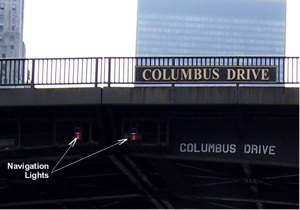
In August 2004, a tour bus for the Dave Mathews Band emptied its waste tank while on a Chicago Bridge just as a tour boat passed under it. Which bridge?
This happened at the Kinzie St. Bridge. While not one of the eighteen here, it is the first street crossing the North Branch heading north from Wolf Point and can be seen from the Lake Street Bridge.

